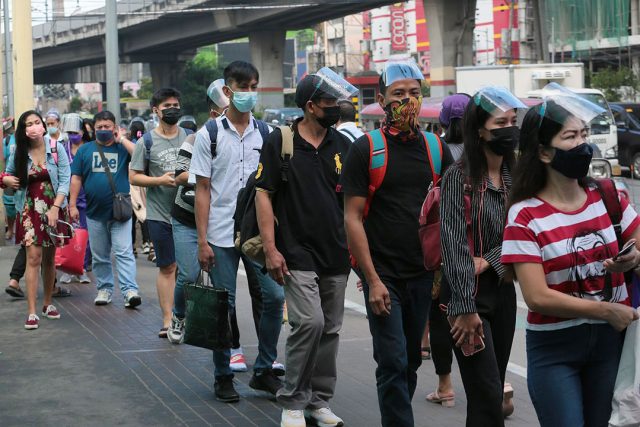By Kyle Aristophere T. Atienza, Reporter
THE PHILIPPINE capital and nearby cities were now at critical risk from the coronavirus, the country’s Health chief said, as the country struggles to contain a fresh surge in infections spurred by the highly mutated Omicron variant.
Metro Manila has been among the top three regions with the most infections, Health Secretary Francisco T. Duque III said in a taped Cabinet meeting aired on Tuesday night.
Coronavirus infections in the capital region have increased almost 15 times in the past two weeks, while the average daily attack rate stood at 8.79, he added.
President Rodrigo R. Duterte raised the virus alert in Metro Manila to Level 3 from Jan. 3 to 15 as the country logged thousands of infections daily from fewer than 500 before the fresh spike.
The Department of Health (DoH) reported 10,775 cases on Wednesday, the highest since Oct. 10 and almost double the 5,434 cases posted on Jan. 4. This brought the total to 2.87 million.
The death toll hit 51,662 after 58 more patients died, while recoveries increased by 605 to 2.78 million, the it said in a bulletin.
The agency said 31.7% of 44,643 samples on Jan 3 tested positive for coronavirus disease 2019 (COVID-19), way above the 5% benchmark set by the World Health Organization.
There were 39,974 active cases, 1,294 of which did not show symptoms, 33,866 were mild, 2,983 were moderate, 1,512 were severe and 319 were critical.
DoH said 99% of the cases occurred from Dec. 23 to Jan. 5. The top regions with new cases in the past two weeks were Metro Manila with 7,420, Calabarzon with 1,719 and Central Luzon with 798. It added that 14% of the deaths occurred in December, 14% in November and 41% in October.
The agency said 39 duplicates had been removed from the Friday tally, 35 of which were recoveries. It added that 110 patients had tested negative and were removed from the count. Fifty-seven recoveries were relisted as deaths. Nine laboratories failed to submit data.
The Health department said 27% of intensive care units in the Philippines were occupied, while the rate for Metro Manila was 37%.
The positivity rate in Metro Manila reached 40% on Tuesday, said Fredegusto P. David, a fellow from the University of the Philippines’ OCTA Research Group.
“It’s the highest that we have seen so far,” he told an online news briefing on Wednesday. “This is already straining our testing capacity, our testing laboratories. We have to augment this with antigen testing.”
Mr. David said Metro Manila had a “very high” reproduction rate of 5%, though healthcare use in the region was at low risk at 34%.
“The overall risk level is high for the National Capital Region and we can see the cases did spike,” he said. “It’s almost vertical and we are about essentially halfway through the effective peak of the previous surge.”
Meanwhile, Mr. Duque said the Calabarzon region was now at high risk from the coronavirus after infections increased almost six times in the past two weeks, with an attack rate of 1.6.
Central Luzon was now under moderate risk after infections rose more than four times. All the other regions were at low to minimal risk.
Bulacan province in Central Luzon and Rizal and Cavite in Calabarzon have been placed under Alert Level 3 from Jan. 5 to 15 amid rising infections.
The third alert level restricts more movements and lowers the operating capacity of some commercial establishments.
On Tuesday, the Calabarzon region posted 868 coronavirus infections, bringing the total to 501,023 with 5,816 deaths. The region had 4,488 active cases as of Jan. 4.
Coronavirus cases in Central Luzon reached 283,300 after it posted 339 new infections, with 2,256 active cases as of Jan. 4. It had 6,171 deaths.
In a related development, the city government of Iloilo confirmed its first case of the heavily mutated Omicron variant. The patient is a 46-year-old seaman who arrived in the country from Kenya on Dec. 16 and traveled to Iloilo City from Cebu on Dec. 24, it said in a statement.
The Omicron case in Iloilo City is “part of previously reported (Omicron cases),” Health director Beverly Lorraine C. Ho told reporters in a Viber message.
The government seeks to inject more coronavirus vaccines amid the threat of the Omicron variant, which has been driving surges worldwide. The government missed its goal of fully vaccinating 54 million people by the end of last year.
About 50.63 million people or 65.63% of the target population had been fully vaccinated against the coronavirus as of Jan. 4, Cabinet Secretary Karlo Alexei B. Nograles said. More than 2.2 million booster shots have been given out.


















